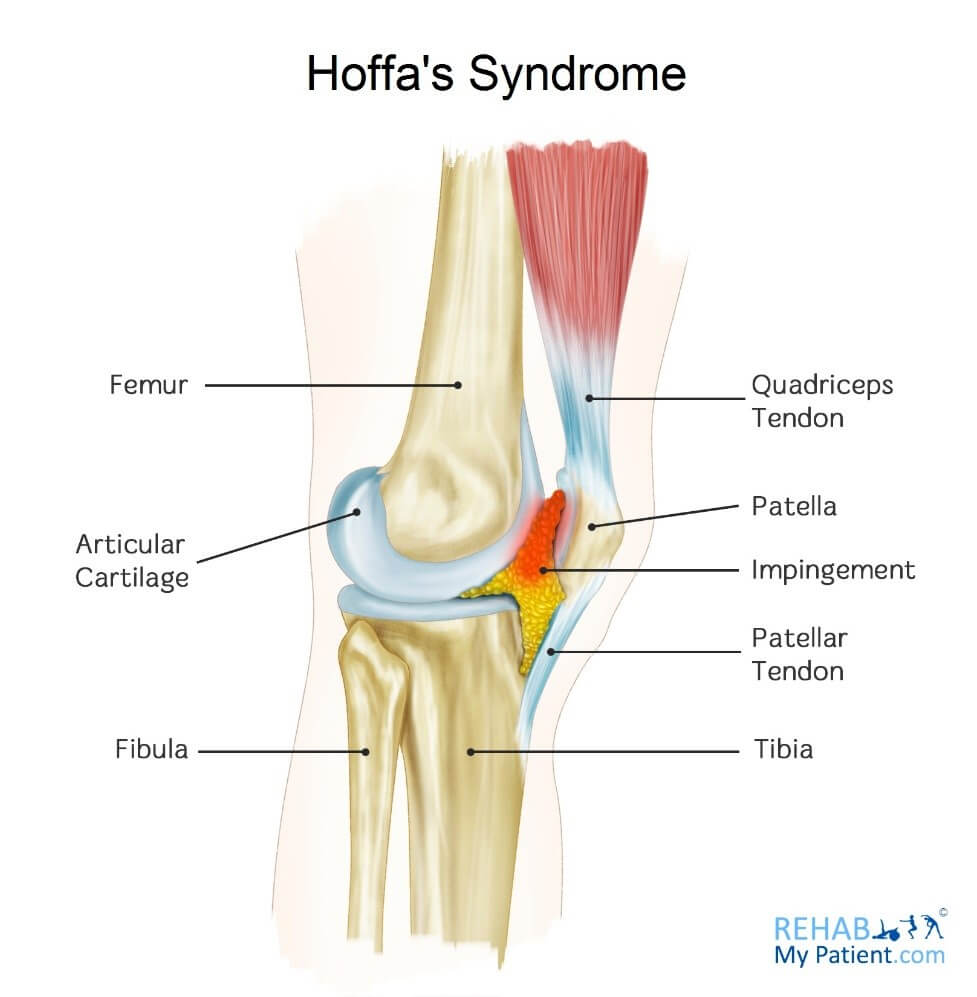Hoffa’s Syndrome
Opublikowano dnia 02nd May 2017 / Opublikowano w: Kolano

Often times after a direct blow to the kneecap, the fat pad can end up becoming impinged between the kneecap and the distal thigh bone. Since the fat pad is one of the most sensitive of all structures within the knee, the condition is thought to be quite painful. The knee lies anteriorly on either side of the lower part of the kneecap. It worsens when straightening the knee joint. The fat pad ends up being constantly irritated and can become substantially inflamed. It has been termed Hoffa’s Syndrome as but can also be known as fat pad impingement.
Patients with Hoffa’s syndrome report having difficulty sitting in tight seats for long periods of time, such as airplane seats or theatre seats. They then report having to straighten their knee every few minutes to stop the pain. On straightening the knee, the knee-cap can give a click which can be painful. This is usually due to inflammation under the knee cap.
Hoffa’s Syndrome Anatomy
The knee is a big strong joint, and is formed of the tibia (shin bone) and femur (thigh bone). There are various fatty pads around the knee which help cushion the overlying tendons. There are also bursae which are fluid filled sacs which cushion the tendons and the bones. Between the knee is cartilage and two structures called menisci (singular = meniscus).
The quadriceps are comprised of four muscles that attach into the patella (knee-cap) and retinaculum surrounding the patella. Tight quadriceps can also contribute to the problem.

How to Treat Hoffa’s Syndrome:
- Rest and Recover
If you find that certain activities are causing you more pain and aggravation, you need to refrain from participating in them. Stop running and start sitting back and relaxing. Off-load your knee to let the inflammation reduce. You may not need complete rest, gentle exercise can also be beneficially, but be careful not to aggravate the knee.
- Ice
Ice can help to reduce inflammation and pain in the affected area. Apply ice to the area for 5-10 minutes at a time three to five times per day. Make sure to wrap the ice in a towel or other item to prevent having an ice burn occur. If ice doesn’t work for you, then you can also try heat via a hot water bottle (again wrapped in a towel so it’s not too hot).
- Muscle Strengthening Exercises
By participating in muscle strengthening exercises, you can maintain the strength and fitness levels of the muscles groups in the surrounding area. When the muscles are stronger, they tend to be able to withstand some of the normal wear and tear better.
- Taping
Taping the patella has also proven beneficial to a number of individuals. One method involves you taping the upper surface of the patella to provide you with more space for all of the structures beneath the lower part of the surface, such as that of the fat pad. This ends up leading to minimal stress and impingement on the pad.
Tips:
- People who participate in sporting activities where blows to the knee are possible, such as rugby, football, hockey and soccer, should be avoided when this injury occurs.
- If you have suffered with an ACL injury, the stability of the knee decreases leaving the fat pad more susceptible to being pinched.
- For those who have IT band syndrome, sustaining this injury is that much easier.
- If you have a history of hyperextending the knee, there is the chance that this condition could occur.
- Runners who have weak hips or excessive pronation might experience a quick inward turn of the leg, while the kneecap remains behind, thus causing a pinching of the fat pad.
Zapisać się
Zarejestruj się już teraz, aby skorzystać z bezpłatnego okresu próbnego!
Zacznij korzystać z Rehab My Patient już dziś i zrewolucjonizuj proces przepisywania ćwiczeń, aby zapewnić sobie skuteczną rehabilitację.
Rozpocznij 14-dniowy bezpłatny okres próbny